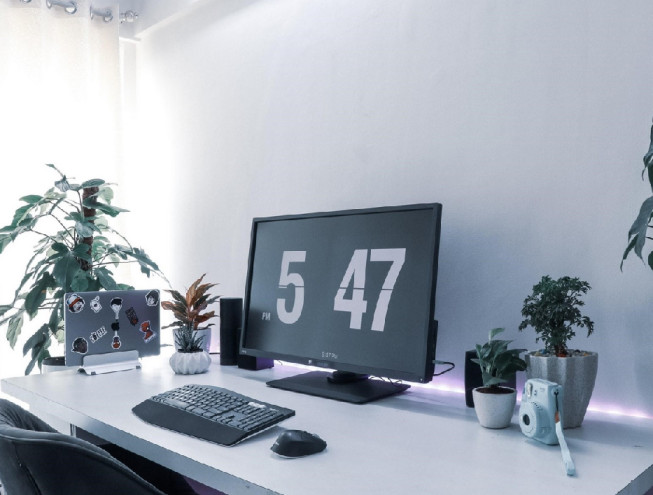If you’re one of the many American adults who works in an office for more than 8 hours a day, you’re probably already aware of the importance of workplace wellness. Even while a desk job isn’t considered “physical” employment, it does have an impact on your body.
Because we spend nearly a third of our waking hours (half of our waking hours!) at work, it’s critical to maintain excellent physical and mental health habits there, which have a significant impact on our overall health and well-being.
It’s no secret that good health is good business.
How to Remain Good Health at Work
1. Create a purposeful workspace :
You may or may not have much control over where your office is located or how it is set up, but workplace wellness starts with the setting we work in. When our office environment fosters favorable working conditions that help us stay inspired, focused, and productive, we are best able to set ourselves up for healthy practices at work.
2. Prioritize an ergonomic setup
Working long hours at a desk with poor posture can (and almost certainly will) cause serious harm to your body. It’s recommended to put your desk, chair (or yoga ball), monitor, and keyboard in the most ergonomic positions possible.
A standing desk is wonderful if you’re interested and able, and your business offers it as an option—as you may know, sitting is bad for your health.
3. Add “office plants” for cleaner air
Plants have been proved to relieve fatigue, increase creativity and productivity, and even make people happier!
4. Get up from your desk on a regular basis Ugh, it’s so difficult, right?
It’s difficult to tear yourself away from the computer for the benefit of your health when you’re busy, overworked, or pressed for time.
However, you should get up from your desk at least every half hour (for your health).For other people, this is nearly impossible, or it causes them to lose focus and productivity, so experiment with the timetable that works best for you.
It’s a good idea to set reminders so you don’t “forget” to get up. Set a 30-minute alarm on your phone, for example. Even standing up and walking around your workplace for a few seconds while turning off the alarm counts as exercise, which is beneficial!
5. Follow the 20/20/20 vision rule
Computer eye strain is real, and it can cause dry eyes, poor vision, and headaches if you don’t follow the 20/20/20 vision rule. It’s a good idea to follow the 20/20/20 rule when working on a computer: every 20 minutes, look at anything 20 feet away for 20 seconds.
6. Develop positive professional connections.
Workplace social turmoil can be extremely detrimental to your overall health. Your coworkers are likely the people with whom you spend the most time in your everyday life. Negative interactions in that area can surely generate stress and discomfort, as well as make you feel less at ease or enthusiastic about going to work.
Develop positive working relationships by being a nice, courteous colleague who is known for being a team player and treating everyone with respect and professionalism. Don’t instigate office drama, and don’t promote it either—both contribute to a poisonous workplace. Though you have no control over how others behave, removing yourself from any unprofessional situation (or speaking up against it) sends a message to your coworkers that you expect professional behavior.
Connecting successfully with others can lead to some of the most fruitful business connections.
Make an effort to get to know your coworkers, especially if you work closely with them—what do they like to do for fun outside of work, what is most important to them, what are their professional goals, and how can you assist them along the way?
7. Dress for the job you want
There’s a proverb that goes, “Dress for the job you want.”
While workplace fashion may appear to be a frivolous addition to a wellness list, we’ve included it since your outward look has a big impact on your confidence and how you feel about yourself at work.
(And your willingness to take risks that will enhance your career is heavily influenced by your confidence!)
Though there’s nothing wrong with wearing work clothing that make you feel good and look the part if that’s what works for you, many people find that wearing work clothes that make them feel good and look the part makes them feel their best.
It’s true that what you wear to work can make you feel more professional, productive, and, most importantly, confident—so go ahead and look the part if you want to!
8. Make a nutritious lunch.
Lunchtime at work might be one of the downsides of otherwise healthy living.
If you don’t prepare ahead for your working lunch, you may find yourself at the whim of whatever options are nearby—which are typically unhealthy and wouldn’t be your first choice if you had more options.
Whether your workplace lunch alternatives make it necessary for you to pack your own healthy lunch or if you have other options, be thoughtful about what you eat for lunch each day and how it contributes to your overall nutrition and healthy eating habits.
Create a weekly meal plan that describes what you’ll eat for lunch each week—this modest effort ensures you have all the components for healthy lunches on hand.
9. Take a walk
Getting outside for a stroll during the day is one of the most beneficial workplace health recommendations, both physically and mentally. Not only does getting some vitamin D and fresh air help improve energy and creativity (especially in the afternoon! ), but it’s also helpful for your overall health.
Even if your company doesn’t allow you to go for spontaneous walks, there are other methods to include walking into your day: offer a walk-and-talk meeting with a coworker; take a walk during your lunch break; make a phone call while walking.
This can also assist you in achieving your daily goal of 10,000 steps!
10. Understand when and how to unplug.
Demanding job duties combined with the increased capacity to connect via cellphones, computers, and wi-fi hot spots results in something that appears to be beneficial but can actually be detrimental: the ability to work at any time and from any location. This is harmful since it can lead to people working all the time and in all places.
For various people, a healthy work/life balance entails different things, but in general, it’s a satisfying blend of work and leisure. For other people, this means working from 9 a.m. to 5 p.m. and then closing down work and spending time with family or friends outside of those hours. For some people, this entails working lengthy, intensive shifts followed by a longer period of time off.
Maintaining a division of work and play that feels balanced and allows you to stay healthy outside of work is not about achieving an exact ratio, but rather about finding the mix that works best for you—finding the mix that works best for you—finding the mix that works best for you—maintaining a division of work and play that feels balanced and allows you to stay healthy outside of work.
It’s crucial to understand not only how often you should step away from your work, but also what you should do when you do: Do you keep your laptop at work so you won’t be tempted to use it at home? Do you have work notifications turned off on your phone?On a family vacation, do you entirely disconnect from the office?
Stepping away from work as needed is also a part of being fresh and healthy for work.








